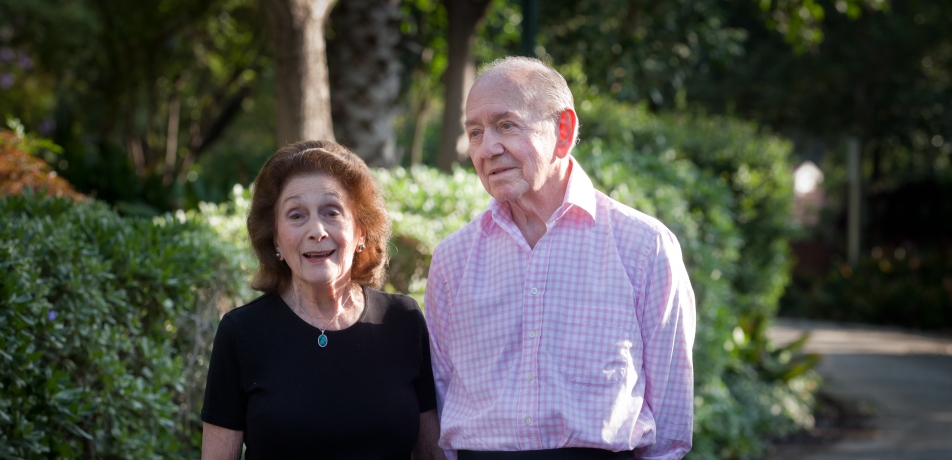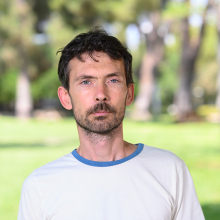A Steward Over Time
Mandy Moross looks back on his relationship with the Weizmann Institute
People behind the science

Since his first visit to the campus in 1956, Mandy Moross has witnessed the transition of the Weizmann Institute to an institution whose scientific accomplishments and technology transfer successes “are massive relative to its size,” he says.
Today, as Chairman of the International Board, Moross, 82, says the Institute is today “in its prime.” And he would know: Though he resides in London, he is intricately familiar with the Institute and can expound on its challenges, goals and history, not unlike a US president giving a State of the Union address.
Mandy and his wife Edna have also given generously to the Weizmann Institute throughout the years; their 1998 gift to establish the M.D. Moross Institute for Cancer Research, for instance, was the biggestever philanthropic donation received by the Weizmann Institute up to that time. And their legacy of leadership and giving has been conveyed to their children. Born and raised in Johannesburg, South Africa— his father was a medical doctor who instilled in him an interest in science—Moross received his undergraduate education in science at Witwatersrand University and enrolled in Harvard Business School at the young age of 19. After graduating, he worked in the UK for Imperial Chemical Industries, married Edna and went back to South Africa, where he worked in the mining industry. In 1970, eschewing apartheid, the family moved back to England.
During his first trip to Israel, shortly after the Suez Crisis in 1956, he visited fellow South African Prof. Peter Hillman, a professor of physics at the Weizmann Institute, where Hillman later headed the Nuclear Physics Department. His meeting with Prof. Amos de-Shalit, who was to become director-general of the Weizmann Institute, made a profound impression on Moross.
In 1963, he came to Israel to meet with Ephraim Ilin, who built Israel’s first car assembly plant. He also met Benjamin Gibli, who was Director of Military Intelligence in the Israel Defense Forces intelligence branch. These meetings were the start of long-term friendships. Gibli introduced him to Moshe Dayan, who was Chief of Staff at the time, and that, too, developed into a lasting friendship. “I learned much from these relationships and began to understand Israel, what it represented, its challenges and potential,” he recalls. Meeting “Dayan, the charismatic soldier, and Gibli (who had been engaged in what became known as the Lavon Affair, Israel’s covert operation in Egypt intended to convince Britain not to withdraw its occupying force in Egypt), coupled with my exposure to the cerebral power at the Weizmann Institute and its exceptional campus, was the start of my meaningful relationship with Israel and Weizmann.”
A commitment to the narrative of Israel and the Jewish people
The Moross’ first major gift to the Weizmann Institute came in 1981, with the establishment of a professorial chair in honor of Mandy’s father - the Dr. Hymie Moross Professorial Chair - and a year later Mandy was elected to the Board of Governors for the first time. Prof Tamar Flash, who explores motor control in humans and the use of robotics, is the current incumbent. The family’s interest in robotics grew and led to the establishment of the Moross Laboratory for the Study of Vision Research and Robotics in 1996, where Prof. Shimon Ullman, the Ruth and Samy Cohn Professor of Computer Sciences, is defining the computations underlying vision and motor control. These studies are leading to a better understanding of the human brain and to the development of a new generation of intelligent and useful computer systems.
The Morosses also acquired the original written correspondence between Dr. Chaim Weizmann and his UK scientist colleague Harold Davis, and donated it to the Institute where it is housed in the archives at Yad Chaim Weizmann. In another tribute to the memory of Dr. Chaim Weizmann, they responded positively to a request from personal friend and Institute supporter David Sieff to fund the restoration of Dr. Weizmann’s laboratory, which is located in the Daniel Sieff building. This “fascinating project,” says Moross, entailed searching for scientific instruments that were used at the time. The lab is a point of interest for many campus guests.
It is the Morosses’ firm belief that the fate of the Jewish people and that of the State of Israel are interdependent. It is this belief that has motivated their strong feelings for Israel. In 1979, the Morosses funded the establishment of a stillthriving community center in Jerusalem’s Old City. They were early supporters of the Israel Museum in Jerusalem and are members of its Directors’ Circle. “Our children share our feelings about Israel, and Weizmann in particular,” says Mandy. “Edna and I could not wish to be more richly rewarded.”
Their son David, who lives in New York and is a member of the International Board, agrees that his father’s passion rubs off of on him and his other siblings: Karen Siem (who is also a Board member), Dominic and Philip. “In the last 20 years, in tandem with my father’s years of deepening involvement with the Weizmann Institute, many of our conversations and e-mail exchanges have involved the subject of Israel and the stimulating pursuit of answers for all of Israel’s challenges and great opportunities. His passion has been a driver for all of us, his children and his grandchildren, in focusing our attention on Israel as the home of the Jewish people. And of course, at the center of his passion for Israel is the Weizmann Institute.”
The importance of philanthropy was also transmitted to the four children “by osmosis,” says Mandy. His daughter Karen recalls the same: “Philanthropy was always part of the value system in our family—it is in our DNA. And at the heart of it has always been the Weizmann Institute, which he views as the jewel in Israel’s crown.” Karen is a generous supporter of women scientists at the Institute and its educational arm, the Davidson Institute of Science Education.
A steward over decades
Throughout the years, Mandy has made substantive changes to the management and financial well-being of the Institute. “There is always more in Mandy’s questions than in many others’ answers,” says Institute President Prof. Daniel Zajfman.
As chair of what was then the Board of Governors, Mandy developed close relationships with the Institute presidents over the years, including Profs. Michael Sela and Haim Harari. The establishment of the M.D. Moross Institute for Cancer Research came in 1998, with the Moross family responding to the Institute’s wish to consolidate its vast and diverse cancer research initiatives under one roof. Mandy received a Ph.D honoris causa the same year.
“I believe Mandy saw in its creation two essential factors,” says Prof. Yoram Groner, the Dr. Barnet Berris Professor of Cancer Research and Head of the Moross Institute for Cancer Research. “First, it would encompass the interdisciplinary research so central to the Institute’s nature. And second, the establishment of such a funding mechanism, which gives support to early-stage research initiatives when external funding is still difficult to obtain, is a very effective tool to leverage the investment. It enables fledgling ideas to advance to a stage in development in which external grants can be obtained with relative ease.”
In his years as president, Prof. Harari (now chairman of the Davidson Institute of Science Education) says Moross initiated important efforts to change the financial management of the Institute. “Mandy prodded and encouraged me to create a central endowment fund for the Institute similar to the Harvard Management Company and those of other American universities. At the time, our funds were invested in multiple places, and we needed centralization and a cohesive strategy,” he says. That effort came to fruition in the form of the Weizmann Global Endowment Management (W-GEM) in 2002, which is managed in New York and functions like most university endowments, in which the interest supports the research and educational needs of the Institute. “Mandy’s business acumen has guided us for many years and the creation of W-GEM was one of his major contributions,” says Harari.
Moross chaired the search committee that selected Prof. Zajfman as president, whom Mandy calls a “tireless, extraordinary leader.” In Zajfman’s first years in office, Moross helped the management make key governance changes, including the creation of an Executive Board to make management more efficient and effective, and the transformation of the Board of Governors into the International Board, with a corresponding change in roles and responsibilities.
Then, in 2009, a new major gift from the family established the Moross School of Mathematics and Computer Sciences, one of the Feinberg Graduate School’s five research schools. “We felt strongly about attracting the best students to the field, providing more of them with exposure to opportunities, the ability to participate in international conferences and better access facilities—thus adding to the quality of education so Israel can continue to be a world leader in computer science,” he says.
He has high hopes for the future, which he rests on the high quality of the scientific talent. “The Institute does a superb job in recruiting the best young scientists to join the faculty,” he says. “And time and again these Israelis come back to Israel (after their postdoctoral fellowships abroad), not only because the Institute makes offers that can closely compete with the best Western universities, but also because their families are in Israel and they want their children to grow up there. To many people who think Israel is under threat, this is an amazing and important thing for them to hear - that this country and this Institute have created the right conditions to bring back the top minds and for these people to educate the next generation of leading scientists.”
A history of commitment
Major gifts to the Weizmann Institute by Mandy and Edna Moross
• Dr. Hymie Moross Professorial Chair (1981)
• Dr. Chaim Weizmann letters (1989)
• Dr. Chaim Weizmann laboratory refurbishment (1993)
• Moross Laboratory for Vision Research and Robotics (1996)
• M.D. Moross Institute for Cancer Research (1998)
• Moross Research School of Mathematics and Computer Sciences (2009)








